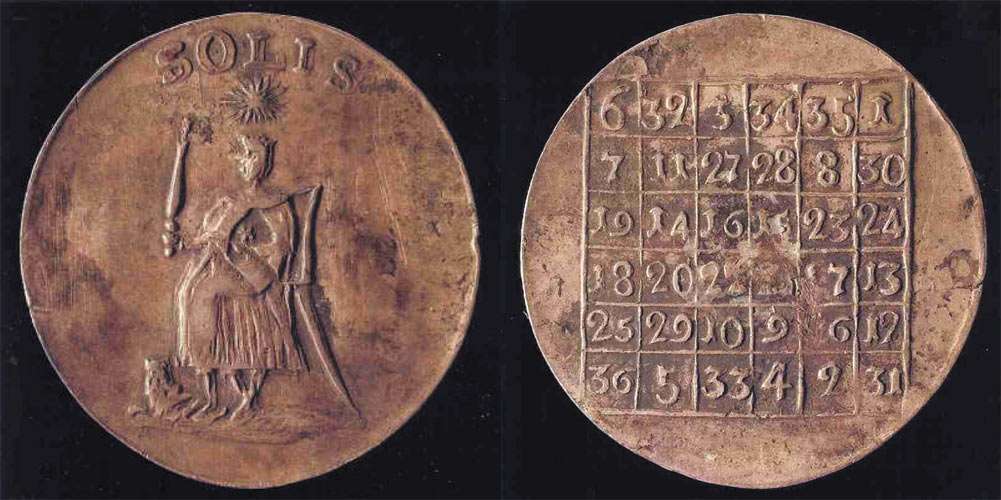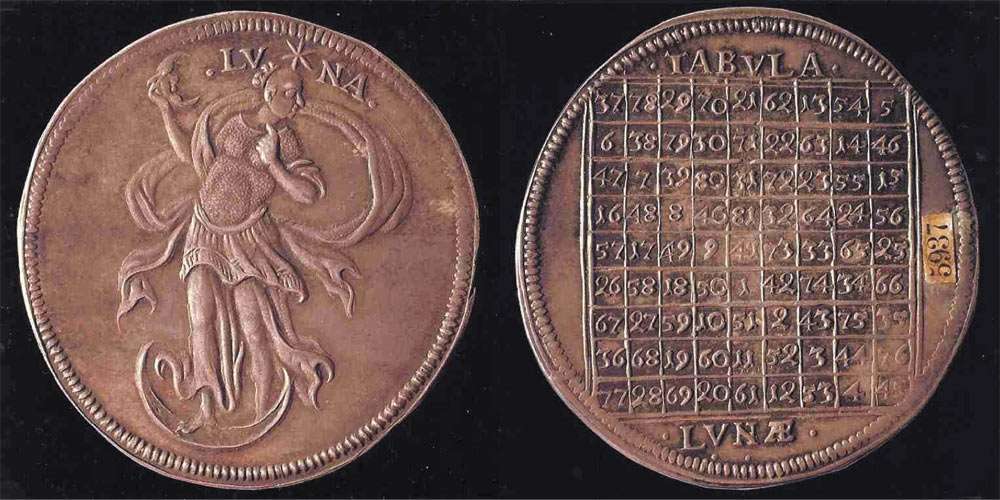
back to The Art of Alchemy index

This article is also available in PDF format.
|
If in the search for the Philosopher's Stone, or in the process of discovering the secret of transmutation, if something could help, the alchemists would incorporate that. Although magic, or the evocation of planetary spirits, was condemned by the Church, it would show up in some alchemical practices. For example, Emperor Rudolf II, (1552-1612), Holy Roman Emperor, King of Hungary and Croatia, King of Bohemia and Archduke of Austria, used an alchemical made magical bell in his alchemical work, to summon the planetary spirits. This bell was made of Electrum magicum, containing the seven planetary metals. Electrum magicum was also used to make other ritual objects in Rosicrucian circles, among which were protective amulets. In those amulets we see a blend of alchemy and magic. Such amulets are also an art form. Not only because of the usual design making and the minting that produces an artistic coin, but also because of the special way of making a magical object. Some of those amulets contained symbols for the seven planets/metals, and the corresponding magic squares. Divine cosmogonic emanations, stellar and planetary spirits, lend their occult powers to these amulets which are engraved with their characters at the appropriate astrological moment. Worn, such talismans were employed for purposes of healing, protection, fertility, the mitigation of various worldly concerns. It was believed that graven images of a talisman are capable of drawing down occult virtues from the celestial realm. A talisman can be considered to be a spiritual storage battery if appropriately charged by the right magician and at the right astrological time. A talisman is only effective when the person who makes it has performed meditations upon each of the symbols inscribed upon it, so that they are full of significance for him. In making these meditations, he builds up a thought-form in the astral light corresponding to each force thus dealt with. When he inscribes a symbol on the talisman, this thought-form he has made is associated with it. Thus it becomes charged, the thought-form in the astral light being a link with the cosmic force represented. Here is text from Albertus Magnus (1193–1280), German Catholic Dominican friar, philosopher, scientist, and bishop, that shows how important astrology was in regard to imbuing the amulets with their appropriate powers. In his De mineralis, or Book Of Minerals, Chapter 3: The reason why the carving of gems was originally recommended, and what help there is in the sigils themselves, page134-137 (of the Dorothy Wickoff translation), he explains: And therefore also in considering the craft of making gems and metallic images in the likeness of the stars, the first teachers and professors of natural science recommended that the carving be done at duly observed times, when the heavenly force is thought to influence the image most strongly, as for instance when many heavenly powers combine in it. And they worked wonders by means of such images. But the heavenly images are helped by many [things]. Nevertheless, there are five things that are especially to be regarded. [The first of these is] the image of the starless sphere, because this circle imparts motion to the constellations and to life. Second, help comes from the constellations, which must be properly observed. And third, from the position of the planets in [certain] Signs [of the Zodiac] which strengthen [other] Signs. Fourth, from the amount of elevation and elongation, according to the latitude and longitude measured from the equinoctial and the ascendant. And fifth, from the relation of all these to the latitude of the clime [where the observation is made]. And the last must be carefully observed, since from this and the preceding [arise] the variations in the size of the angle at which the rays strike the figure of anything produced by nature or by art. And it is in accordance with the size of this angle that the powers of heaven are poured into things. Few people make these observations, and fewer still know how to make them; and when they try, without such knowledge, to practise the art of images, their own failures cause them to believe that the science is a failure, and they bring it into disrepute. Such then are the recommendations, and the reasons [for them], concerning the carving of gems with the images of heaven. [Clime (clima) is a belt on the earth's surface bounded by parallels of latitude {see n, iii, 4, note 3 ). Since the times of risings and settings of stars and their height above the horizon all vary, not only with the seasons but also with the latitude of the observer, it is necessary to make proper correction for latitude in using astronomical tables that were prepared for another place.] |
|
This is one of a series of German healing alchemy coins that would protect the wearer against disease and ill health. It is marked with a number of alchemy symbols. It is from the 18-19th century. According the museum's information, it was made of the seven planetary metals of alchemy, which are lead, tin, iron, gold, copper, mercury and silver. Such a material was called electrum, or with its Latin name Electrum magicum. Objects made from electrum were primarily used in magical practices. One side displays a sun with symbols of the other six planets around. The other side of the coin has a German text which reads: "For Flux, Cramps and Erysipelas when it is carried by people." (right image) Flux was a name given to dysentery; erysipelas is a bacterial skin infection. Displayed in the Wellcome Collection museum in London, England. |
|
|
|
Stanislas Klossowski de Rola, a scholar of alchemy, shows us a Rosicrucian amulet he has in his possession. One side has a central sun with the signs of the seven planets around it, and in the outer circle their names. Also notice the octagram. The other side shows Christ at the well bestowing the same supreme gift: "But whosoever drinketh of the water that I shall give him shall never thirst; but the water that I shall give him shall be in him a well of water springing up into everlasting life." This is from the Gospel of John 4. 14. This was posted on the Alchemy Website. |
|
|
|
This Rosicrucian amulet I found on the Sixbid auction website. It is also in the Numista catalog described as being made of brass, and 48.8 mm (1.9") in diameter, and as an alchemist amulet from Germany. One side has a number of strange symbol, with a text around: DIESES METALL DIENET VOR DIE FLVSS (THIS METAL IS USED IN FRONT OF THE RIVER). The square in the middle is surrounded by a circle which contains the Latin words for the four elements: AQUA, AER, IGNIS and TERRA. Inside the square are more alchemical symbols. The details of all these are not visible in this amulet, but are clearer in the the following two amulets which are the same. The other side is the same as the previous amulet with the seven planets and octagram. |
|
|
|
This is the same amulet as the previous one, but better preserved, and more detail is visible. It was found, among other artifacts, in 2016-2019, during renovation work of the "Noorderleien", a boulevard in Antwerp, Belgium. It was once the site of one of the five main entrances of the walled city during the Spanish occupation between 1542 and 1554. The amulet is dated from the 16-17th century. |
|
|
|
This is from the Science Museum in London, England. It is described as being a lead amulet with alchemical symbols dating from 1550 to 1680. Only one side is displayed. |
|
|
|
This amulet was on EasyLiveAuction website. It is 48.8 mm (1.9") in diameter. This one is said to be made out of pewter. It again has the seven planets on one side, with octagram. The other side has the same cryptic symbols as the previous amulet, but this time it has a pentagram inside with some other symbols. |
|
|
|
Four Silver Magic/Rosicrucian Medals The following four pieces are in the Germanischen National Museum in Nuremberg, Germany. They are described as alchemical medals. They were tested in an isotropic analysis, that revealed that the silver is entirely natural, that is from a silver mine, as thus not from alchemical transmutation. These are rather magical amulets made by an alchemist, as three of them are associated with a planet, and contain magic squares. This was typical for Rosicrucian amulets. The Rosy and Gold Cross at that time was also engaged in alchemy. The fourth amulet is clearly a Rosicrucian one, with alchemical symbols. Nevertheless they are fine examples of what alchemists produced in those times as alleged transmuted silver and as works of art on the sides of the medals, with their occult or esoteric symbols. Click on the images to enlarge. |
 GNM#6215 : Solis medal in the Germanischen National Museum in Nuremberg, Germany. Image of the sun portrayed as a ruler sitting on a throne, with staff in hand, and star above his head, with the word SOLIS (sun); the other side has the magic square of the Sun. |
 GNM#5937, Luna medal in the Germanischen National Museum in Nuremberg, Germany. One side has the image of the moon goddess Luna, standing on a moon, holding another moon in her right hand, and having a star above the head. On the other side is another Magic square of the Moon (TABVLA LVNA). |
|
GNM#6010: Unbekannt medal in the Germanischen National Museum in Nuremberg, Germany. Silver medal with astrological/magical connotations.. A crab with a star on its back, and a quarter moon on the right side (in astrology, The Moon Rules the Sign of Cancer, the crab). On its left side is the text X.OCTOB:MDCCV (October 10th, 1705). The text in the outer circle reads: DIANAE ET IOVIS AMORES (the love of Diana (the moon goddess) and Jupiter). The other side has a magic square, with moon on top, and numbers on the four sides. The nine rows and columns form the magic square of the Moon. Each row, column and diagonal adds up to 369, the number underneath the moon. All of the numbers in the square add up to 3321, the number at the bottom. The only description I found was in Verzeichniß einer ansehnlichen Sammlung merkwürdiger und seltener Thaler, Münzen und Medaillen, published in Hamburg, 1783, page 451. |
|
GNM#5948, Rosenkreuser medal in the Germanischen National Museum in Nuremberg, Germany. A snake is half-encircling three concentric circles. In the center is a square which contains two interlocking triangles. In the inside corners of the square are the signs for the Four Elements. At the center is a small circle within a slightly larger circle. Above the square is the sign of Mercury, underneath is the word SPIRITVS (spirit). Below is a sign for salt, and the word CORPVS. Left and right of the square is the symbol for sulfur and the word ANIMA (soul). The text in the outer circle reads: Natura activa laetatur Nature passiva! (Active Nature rejoices in passive Nature). The design is taken from a Rosicrucian work by J.G. Toeltius: Coelum reseratum chymicum oder philosophischer Tractat oder Philosophischer Tractat worinne nicht allein die Materien und Handgriffe, Frankfurt 1737 (Frontispiece engraving):
The other side of the medal has a cross with a crown at the top and the letters F R C A. F.R.C. or Frater Rosae Crucis is the title awarded to advanced members of the Rosicrucian Order. |